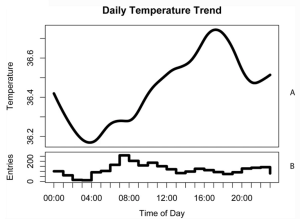
Researchers studying the body temperatures of people have determined that 98.6°F isn’t really normal; other research also shows that the typical body temperature is cooling with time. While many have grown up with the understanding that 98.6 °F (or 37°C) is normal and anything more, especially approaching or exceeding 100°F is a fever, new data shows that isn’t correct.
Many consider a fever as the most common first symptom of illness. A single study in 1868 determined that 98.6°F should be considered normal. Since then, there have been numerous studies that show temperatures are much more flexible, with fluctuations based on things like circadian rhythm, age, gender, and ethnicity.
In 2018, a study called, “Using Smartphone Crowdsourcing to Redefine Normal and Febrile Temperatures in Adults: Results from the Feverprints Study” leveraged the Feverprint mobile app to better monitor and track people’s temperatures. According to the study, “Researchers can now rapidly recruit large numbers of patients and crowdsource their data through platforms such as ResearchKit (Apple).” To participate in the study, people leveraged the Apple app and opted in to share their data; children and adults living in the United States and who owned thermometers were eligible to participate. Surveys assessed demographics, medical and family history, and medications of each program participant. Using the app, study participants manually recorded temperatures, associated symptoms, and antipyretic use within Feverprints. As part of this study, the Boston Children’s Hospital Institutional Review Board approved the format of the study.

As part of this study, which is available for review here, 329 participants provided 5,038 oral temperature readings. Through that analysis, study authors found an average normal temperature in adults of 97.7°F, as measured with an oral thermometer; the analysis found that fever begins on average at 99.5°F.
The study also aligns with other reports that show temperatures fluctuate over time; they fall at night and gradually rise later in the day.
With hundreds of thousands of data points, others have calculated body temperature compared with birth years and found that the average body temperature in men and women has gone down .05°F per birth decade.
In a report released this January called, “Decreasing human body temperature in the United States since the Industrial Revolution”, which is available here, analysis shows that human body temperature has declined over the last 157 years records were available.
Scientists aren’t completely sure why this trend is happening, but they hypothesize better health and better climate control is responsible. Air conditioning and heat is able to better regulate the climate that people live and work in now much better than was possible more than 100 years ago; because the body doesn’t need to work hard to adjust to changing temperatures, scientists hypothesize that could be a factor to somewhat lower body temperatures. Others believe overall improvement of health is the reason: a healthier body runs more “efficiently” while a sick or challenged body tends to run warmer.